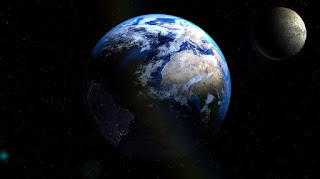Newton's Law Of Gravitation:
Newton's Law of gravitation states that,"Every particle of matter attracts every other particle of matter with a force which is directly proportional to the product of their masses and inversely proportional to the square of the distance between them."
F ∝ M m
F ∝ 1/r²
∴ F ∝ M m/r²
∴ F = G M m/r²
G is a universal gravitational constant
SI Unit of universal gravitational constant is Nm²/kg².
And the C. G. S. unit is dynecm²/g²
Value Of G is 6.673×10^-11
And the dimension of G is
👉 Acceleration due to gravity (g)
👉 Variation of 'g' due to Altitude, Latitude and Depth
👉 Study of Satellite
1) Projection of satellite
2) Periodic time of satellite
3) Binding energy and Escape velocity of satellite.
👉 Kepler's law of motion
👉 Weightlessness.
👉 Uses of satellite.
👉 About Planets
👉 Black Hole
👉 Acceleration due to gravity (g)
Let M is mass of the earth, R is radius of the earth. Consider an object of mass m situated on the surface of the earth, g is the gravitational acceleration due to gravity at the earth's surface. The weight of the object is equal to gravitational Force acting on it.
On earth surface,
Weight of the object = Gravitational force
mg = GMm/R²
g = GM /R²
At height h,
gh = GM /(R+h)²
or gh = g (R/R+h)²
👉 Variation of 'g' due to Altitude, Latitude and Depth
(1) Variation of g due to Altitude
gh = g [1-2h/R]
(2) Variation of g due to Depth
gd = g [1-d/R]
(3) Variation of g due to Latitude
g' = g - R⍵²θ²
Variation of g due to latitude at sea level
| Latitude | g (m/s²) |
| 0⁰ | 9.7804 |
| 10⁰ | 9.7819 |
| 20⁰ | 9.7864 |
| 30⁰ | 9.7933 |
| 40⁰ | 9.8017 |
| 50⁰ | 9.8107 |
| 60⁰ | 9.8192 |
| 70⁰ | 9.8261 |
| 80⁰ | 9.8306 |
| 90⁰ | 9.8322 |
👉Study of Satellite
Projection of satellite
Satellite means an object which revolves in an orbit around a planet. There is many artificial satellite which is man made & Moon is the natural satellite of the Earth.
For projection of satellite there is minimum two stage rocket is used. In this rocket satellite is kept at the tip means at the top position. Initially the fuel in the first stage of the rocket is ignited on earth surface , so the rocket riser to desired height. Now by remote control, the empty first stage is detached from rocket and rocket rotates 90 degree so that it points in horizontal direction. When fuel in second stage is completely burn then second stage is detached. The resulting motion of the satellite depends upon the velocity of the projection given to it.
" Critical Velocity, the minimum horizontal velocity of projection that must be given to a satellite at a certain height, so it can revolve in a circular orbit around earth.
" Escape Velocity, the minimum velocity with which a body should be projected from the surface of the earth, so that it escape from the earth's gravitational field.
Different cases of projection of satellite
Satellite moves in elliptical orbit, when the velocity of the projection is less than the critical velocity. But the point of projection is apogee and in the orbit the satellite comes closer to the earth with its perigee point lying at 180 degree. If it enters the atmosphere while coming towards perigee it will loose energy and spiral down. If does not enter the atmosphere, it will continue to move in elliptical orbit.
Elliptical orbit when Vc<V<Ve
If the velocity of projection is greater than the critical velocity but less than the escape velocity, then the satellite moves in elliptical orbit and its apogee, or point of greatest distance from the earth, will be greater than projection height.
Circular orbit when V = Vc
Satellite moves in circular orbit around the earth when velocity of the projection is equal to the critical velocity.
Parabolic path when V =Ve
Satellite moves in parabolic path when velocity of projection is equal to escape velocity.
Hyperbolic path when V>Ve
Satellite escape from gravitational pull of the earth and travel infinitely when the velocity of projection is greater than the escape velocity and when the orbit is hyperbolic
Periodic time of satellite
The time taken by the satellite to complete one revolution round the earth is called its period or periodic time (T).
👉 Kepler's law of motion
Kepler's first law (Law of orbit)
Every planet revolves in an elliptical orbit round the sun, with the sun situated at one of the focii of the ellipse.
Kepler's second law (Law of areas)
The radius vector drawn from the sun to any planet sweeps out equal areas in equal intervals of time.
i.e. The areal vector of the radius vector is constant.
[ According to the Kepler's second law, when a planet is closest to the rain, its speed is maximum and when it is farthest from the sun its speed is minimum ]
Kepler's third law (Law of period)
The square of the period of revolution of the planet around the sun is directly proportional to the cube of the semi major axis of the elliptical orbit. This law is known as the harmonic law.






No comments:
Post a Comment
Discuss Problem and answers here to grow up by discussion